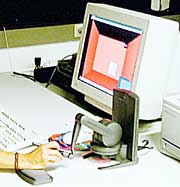A mechanical arm translates data transmitted on the Internet into a physical sensation of the person holding it
 By: Yuval Dror
By: Yuval Dror
The "Phantom" mechanical arm. Huge commercial potential
The box appeared on the screen. It looked like a cartoon box, completely normal. On both sides of the Atlantic Ocean, two scientists sat down next to a mechanical arm shaped like a thick pencil. They grabbed her arm and lifted the virtual box up. Later they said: "The box doesn't really exist, it's virtual - yet we felt like it was made of rubber." The scientists said these things the other day, at the end of the experiment that sought to transmit through the Internet sensations felt with the help of the sense of touch. The scientists explain that this experiment may open a window to a large number of new technologies for various uses, including virtual sex.
Apparently, the goal that the scientists are striving for is not complex. The internet is
An interactive medium that allows remote people to communicate with each other. However, until
So many experiments that succeeded in translating the interactive ability have not been reported
of the network for a physical sensation. The current experiment is part of a university project
UCL in London and MIT University in the USA - is trying to do this through integration
of modern technologies and high speed Internet access. the breakthrough
The first in the field was achieved in a similar internal experiment conducted on May 23. the experiment
which was carried out yesterday, is the first public experiment conducted in the field.
In the experiment, the scientists used a mechanical arm known as a "phantom", which was developed in the middle
90s at MIT's Touch Labs and is now sold commercially by a company
.Sensable Technologies
In the experiment, a diagram of a XNUMXD room with a XNUMXD box appeared on the screen
and two plus-shaped markers, representing the location of each of the scientists in the room
the virtual. The scientists moved the mechanical arm until it was close to the box
Then they tried to pick her up - one from the right and the other from the left - and hold her
In the air. Through the mechanical arm, the scientists felt the "push" resistance of the side
On the other hand, they also felt the surface of the surface they touched virtually.
About four years ago, Srinivasan's team managed to transfer a feeling between two
computers that were located in adjacent rooms. "As far as we know, this is the time
The first time that a feeling was broadcast over such a great distance of about 4,800 kilometers," he said
Professor Mandyam Srinivasan from MIT in an interview with the website Science Daily
The problem with transferring information simulating a feeling on the Internet is the need for bandwidth
Big enough, that it can contain all the information that is transferred in the network that is transferred in the arm
the mechanical "Sense of touch is the most difficult part to image in a virtual environment",
said Professor Mel Slater from the Department of Computer Science at UCL University. But
Our experiment with MIT shows that the effort justifies itself."
The field of virtual reality was considered innovative and promising in the early 90s, but not yet
Accessories were developed in the field that were commercially successful. However, the commercial potential
In the field it is huge: using the new technology it will be possible to train Magali
Mines (each mine has a different feel); to create simulations in the field of medicine
the surgeon; And of course to produce accessories that enable virtual intercourse
through the Internet. "We don't really know what the real potential of
This technology," said Srinivasan. "As Alexander Graham Bell cannot
It was to predict all the applications developed on the basis of the phone".
Sensable Technologies
